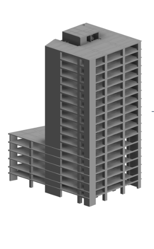BIM & Management
Step into the realm of Building Information Modeling & Management, where precision meets efficiency and creativity reigns supreme. Discover the art of seamlessly integrating technology and project management, as we unravel the wonders of Building Information Modeling. Get ready to unlock new possibilities and navigate the complexities of modern construction with finesse. Embrace the future of construction management with us!


Building Information Modeling (BIM) refers to the comprehensive procedure of generating and overseeing data for a constructed asset. Utilizing an intelligent model and facilitated by a cloud platform, BIM combines organized, multi-disciplinary data to create a digital portrayal of an asset throughout its entire lifecycle, encompassing planning, design, construction, and operations.
Information Modeling
BIM Implementation
The BIM implementation process involves several key steps to successfully integrate Building Information Modeling into a construction project
01 BIM Planning and Strategy
02 BIM Kickoff and Training
03 BIM Modeling and Data Creation
04 BIM Coordination & Collaboration
05 BIM Management and Documentation
06 BIM in Construction and Operation
07 Review and Continuous Improvement
Coordination
"BIM coordination" refers to the process of coordinating Building Information Modeling (BIM) data and models among different stakeholders involved in a construction project. BIM is a digital representation of the physical and functional characteristics of a building or infrastructure. It encompasses information about the building's design, construction, and operation.


Estimation & Costing
Not just pleasant on the outside, our Pleasantview Gem Inn properties are especially popular among families. With underground parking and floor-to-ceiling windows, there's no shortage of natural light or space.


BIM Management
Industry Foundation Class
Industry Foundation Classes (IFC) are an open and neutral file format used in the architecture, engineering, and construction (AEC) industry for the exchange of information between various software applications. IFC serves as a common language for data exchange, enabling interoperability and collaboration among different stakeholders involved in the building lifecycle. By providing a standardized data model, IFC facilitates the seamless sharing of building information, including geometry, attributes, relationships, and more. This promotes efficient communication, reduces errors, and enhances overall project coordination in the AEC industry.
COBie
COBie, which stands for Construction Operations Building Information Exchange, is a data format and information exchange standard used in the architecture, engineering, construction, and operations (AECO) industry. It aims to streamline the exchange of building information between different stakeholders throughout the lifecycle of a project. COBie focuses on capturing and organizing essential construction and facility management data, including equipment lists, warranty information, maintenance schedules, and more. By utilizing COBie, project teams can improve communication, collaboration, and data interoperability, leading to enhanced facility operations and maintenance processes.
Construction Operations Building Information Exchange
Address
Fulia,Snatipur
WB, India- 741402
Contacts
Have a project in mind ?
Copyright © 2025 Zspecies - BIM Research Lab
